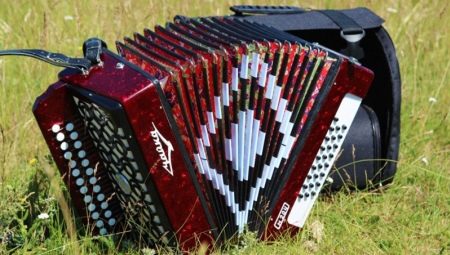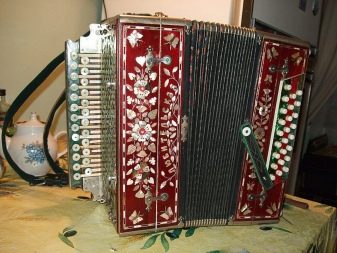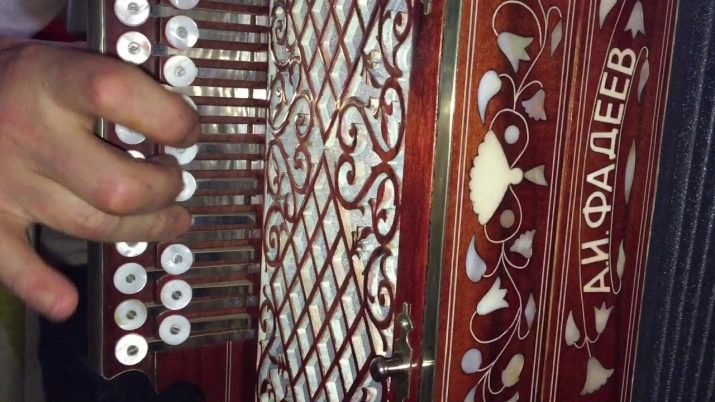All about accordion

If you are interested in music, you should learn everything about accordion, what it is and how it differs from other instruments. Russian hand-held harmonica, talianka and other types deserve attention no less than grand pianos, violins or guitars. The sound of this musical instrument is very good, but one must take into account the differences between the two-row and single-row accordions, the peculiarities of their tuning.


What it is?
The term "accordion" is everyday; officially this hand-held musical instrument is called the harmonica. It belongs to the reed group. This classification is associated with the use of special slipping "tongues" made of metal to obtain sound. They are oscillated by the air flow created by the bellows. There are quite a few types of harmonics - but this needs to be discussed separately.


A characteristic feature of any such instrument is the diatonic scale. The accordion looks simple: a keyboard is installed on it, and the instrument itself stretches well. Technically similar products consist of two half-cases (on which the keys are carried out). The same fur is located between them.
Depending on the weight of the structure, both holding in the hands and hanging with a belt can be provided.

History
Versions of creating an accordion are quite diverse. You can often find a mention that it appeared thanks to Ivan Sizov. In 1830 he began to make such instruments for the first time in our country. However, it was only after switching to the reverse system that it was possible to obtain a specific sound that is characteristic of the Russian accordion.By the middle of the 19th century, there were 6 large factories in Tula and many small workshops where artels worked.


Gradually, a number of local traditions and nuances appeared. And everywhere they made their own instruments, not the same as in other places. Despite some old-fashionedness, they play the harmonica today, in the 21st century. However, the opinion that it was invented in Russia is incorrect. The exact name of the inventor can hardly be established.

At the same time, there is no doubt that the early prototypes of the accordion - portable organs - were already known in the 18th century. It is also known that the first, close to the modern model, the instrument was presented in 1812 by Friedrich Buschmann. It was he who adapted the fur in practice to supply air to the tongue. But the performance capabilities of this design were limited.

The decisive step, most likely, was taken by Cyril Demian in Vienna in 1829. It was Demian who came up with the idea of dividing the body and joining its parts with fur. It was this decision that made it possible to achieve a previously unattainable sound level. Soon accordions (then called accordions) became popular in many countries, and there was a clear difference between the Austrian and German varieties (in terms of valve arrangement).
In Russia, in the 1830s, at first, imported samples were copied, but then they began to be finalized - and this is how the page in the history of the harmonica described earlier began.

Views
All the first accordions belonged to the single-row variety, and they had from 5 to 10 keys on the right and 2 buttons on the left. Mostly they used a seven-key instrument. When they unclenched and squeezed the fur, even with the same key, they received different sounds. The original German prototype in our country was changed in such a way as to improve the reception of tonic harmony. but single-row designs had another serious problem - the accompaniment was limited and not free, which also did not allow the normal playing of Russian songs.

Despite some individual improvements, which gave a relatively good result, it became possible to radically improve it only after the appearance of a two-row accordion. The second row of keys produced sounds one fourth higher. Gradually, the developers began to introduce minor chords and chromatic sounds. Attention was also paid to the mechanics of the left keyboard. The culmination of the development of the classic two-row instrument was the "wreaths" of the Tula model.

A new step forward was associated with the emergence of a chromatic two-row design. It was its creation in the 1870s that later allowed the offshoot to form, which eventually led to the button accordion. Beloborodov's model has also undergone improvements. We tried to expand its timbre as much as possible.
At the turn of the 19th – 20th centuries, three-row and four-row harmonics appeared, which experts consider the first Russian button accordions.

The systems of Hegstrom, Mirwald and Sterligov, created during this period, were actively used until 1930. But today it has already passed the stage. Now the type of wind concert accordion has fully developed and streamlined. A number of large factories produce equipment for playing concerts.

Russian regional
A single-row hand accordion appears under the name of a talisman. In the century before last, it was actively used on the Volga and in the northern regions of Russia. On the right, such an instrument has 12-15 elongated keys. On the left, there are 3–6 keys imitating the ringing of bells. To the accompaniment of talyans in different places, they could both sing ditties and dance.

The Nizhny Novgorod variety of the instrument is highly valued for the brightness of sound and depth of timbre. Such a design was created by the famous craftsmen, the Potekhin brothers. The body is made of alder. But, in addition to it, the high dynamic capabilities of the harmonic are also associated with the borrowed mechanics of the right keyboard, introduced with the same number of language bars.

The Nizhny Novgorod approach also consists in horizontal placement of the voice bars on the right. This solution allows the air flow to be directly applied to the reeds and guarantee a quick sound generation. The valves and openings are relatively small, which leads to a minimum of air loss during the game. The Nizhny Novgorod instrument is heavier than usual and is also distinguished by a reduced scale on both keyboards. Attempts to add a fifth and subsequent voices did not give a good result, so there are only models with 4 voices.

Cyril accordions originate from the Vologda region. They have been known for about 150 years. They were made in the village of Volokoslavinskoe, but the instrument gained wide popularity in various regions. You can play the Cyril accordion in a completely unique way, achieving an original flavor. The Kirillov concept implies full production from alder - not excluding the deck, which is usually made from plywood or duralumin in factories; this approach makes the device lighter.

The Livenskaya system was created by processing the Tula prototype. Initially, it provided for monophonic sound. But gradually Livny mastered the production of two-voice and even three-voice designs. These tools were very expensive; the body is three times higher in height than in width. Now they are actively used by advanced accordionists.

Since the air cavity is small, the fur is distinguished by a significant number of folds. Shoulder straps are not provided. The harmony will sound the same regardless of the direction the fur moves. The rows of right keys are 12–18 pieces. Separately, it is worth talking about the Kirov or Vyatka accordion variation.
The mass of such products is 4.2 kg. They are comfortable to play in any position. The Vyatka mechanism is simple and reliable, it is distinguished by the full return of sound. The bodies and decks are usually made from birch, which allows for excellent timbre. Hands do not get tired when playing the Vyatka harmonics.

There is also no other discomfort. Increased sound saturation is noted. The vocal parts are subjected to special heat treatment. This allows you to guarantee high volume during active play, prevent oxidation and greatly increase the service time. The increase in sound output is ensured by tightly pressing the resonator to the soundboard along its entire length.

Chrome
This is a Vologda construction, created about 100 years ago by Nikolai Smyslov and originally called "Severyanka". The peculiarity of the instrument is that its sound does not depend on the direction in which the fur moves. The demand for such a solution was characteristic, however, not earlier than in the mid-1910s. By the end of the first third of the century, the lamella completely replaced the Viennese and other early types of diatonic harmonics. Its leadership continues into the 21st century.

The earliest chrome kits had 21-key right keyboards and 12-key left keyboards. Bass and chords were separate. But modern manufacturers prefer to release models with 25 keys on each side. This is conventionally referred to as a 25x25 scheme.
For chromos, the tonality of the major scale and the diatonic scale are typical.


Accordion
Under this name they sell chromatic hand accordions with 3-6 rows of round keys on the melodic keyboard and 5-6 rows of keys on the keyboard for accompaniment. Bayans began to be produced in the 1890s, when the construction of Mirwald's harmonica was borrowed in Moscow, slightly improving it. The roller mechanism is better than the original bent arm version. The button accordion was improved largely thanks to the efforts of Peter Sterligov. It is customary to name the vertical levels of buttons on accordion keyboards starting from the fur.

The repetitions of the bass and chord buttons play an important role. The auxiliary rows on the right keyboard are also very significant. Both of these solutions are associated with the unity of the fingering in all keys. On the right accordion keyboard there can be 3 or 5 rows.Occasionally there are four-row and six-row models.

Harmonics of the peoples of Russia and the republics of the USSR
In the Mari musical tradition, marla-carmon is known. This tool has a single row structure. It has 7 keys; it is believed that gauze-carmon was created on the basis of the Vyatka accordion. The sound scale is adapted to the specifics of national music. Even within its framework, it is more and more displaced, however, by two-row harmonics and button accordions.

The Tatar harmonica also repelled from the Vyatka pattern. It is built according to the 12x3 system. It is very difficult to confuse its timbre with something else. For many years now, such an instrument has been produced in Kazan. There are models of the same type with a 16x12 formula, as well as a two-row koga-carmon.

Oriental button accordions are also made in Kazan. They are distinguished by a chromatic scale atypical for oriental instruments. The accompaniment is the same as for standard accordions and button accordions. The earliest versions were produced for a short time due to poor design. The Eastern Elective Harmonica emerged in the early 1960s, and its relevance has grown dramatically since then; the usual formulas are 27x24 or 30x30.

There are also:
-
traditional Georgian harmonica (appeared in the 19th century, is divided into 3 types);
-
single-row accordion komuz;
-
Adyghe pshine;
-
Ossetian iron-kandzal-fandir.

Foreign
Bandoneon is an instrument named after its creator G. Banda. First of all, such a model of the accordion was used in German churches for the performance of specific music. By the end of the 19th century, it spread in Argentina and brought that very original sound to tango. Mastering the bandoneon is very difficult, much harder than any ordinary harmonica.
This instrument can have 106-148 tones, but most often bandeonists use 144-tone models, and beginners choose the 110-tone version.

The accordion is also a kind of accordion. The chromatic scale is typical for him. The accordion has registers that change timbre. This allows you to reproduce the sound of dissimilar instruments. The dynamic flexibility of the accordion is unusually high; it is highly demanded in:
-
USA;
-
Japan;
-
Canada;
-
Germany;
-
Sweden;
-
Great Britain;
-
Brazil.

Concert accordions can weigh 15 kg. The keyboard can be either key or push-button type. In the first case, its piano structure is used; accordion sizes can vary significantly. Accordionists play jazz and dance music. They can perform piano, harpsichord and even organ pieces.

Concertina deserves attention, that is, the harmonica in which there are no ready-made chords. It is a lightweight instrument weighing approximately 1 kg and easy to learn. They created a concertina in Great Britain, at about the same time as the classical accordion was invented. It is worth noting that this is a whole family, different representatives of which are produced in different countries both by factories and by private practitioners. Since the middle of the 19th century, the design scheme has changed little.

Setting and playing technique
Harmonics are often played by numbers. They represent chords, doubles and triplets. Tabs are used mainly for labial, and not for manual accordions. To determine the key of the instrument, you need to use a tuner. It is better to focus on tones that are close to your voice.
This is especially important for non-professional singers who can hardly vary the timbre of singing.


On the Internet you can find ready-made collections of sounds with a given key. To tune a harmonic, a strict constant air pressure is required. It should be such that the sound comes out at a medium volume. If the air presses on the tongue too hard, the vibrations may break. At the initial tuning of the instrument, the accuracy should be 1/2 semitone, and before an important performance - already 1/32 semitone (it is better to finish with such an accurate adjustment always so that it goes "automatically").









